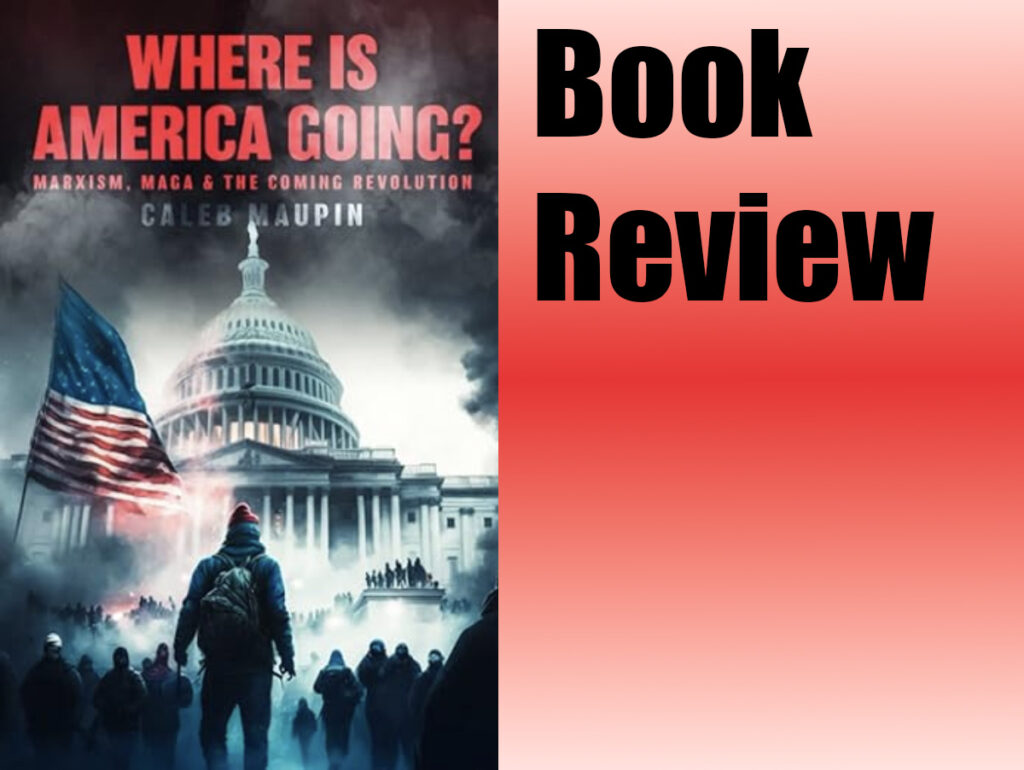Your browser is not compatible with this application. Please use the latest version of Google Chrome, Mozilla Firefox, Microsoft Edge or Safari.
Where Is America Going? by Caleb Maupin Book Review

In May 2023, International Media Journalist and CPI Ideological Leader Caleb Maupin published his book Where is America Going?: Marxism, MAGA and the Coming Revolution Available Here. The book is an ideological and tactical guide-book for all Americans seeking to advance past the age of imperialism and poverty. Innovator Galina has since written a review, published below.
As Americans, we all live with the urgent question Caleb Maupin addresses in his latest book: Where Is America Going? And if we want to know where we are going – it surely follows that we need to know where we came from. Moreover, whether we like it or not, we must also acknowledge that America does not live apart from everyone else on this circular planet of ours, and we need to examine our relationship with the rest of the world.
Unsurprising for those of us who try to keep up with Caleb Maupin on his streams, he fearlessly tackles complicated issues of world history. He is highly qualified to do so as he has read scores of books on all relevant topics, and is remarkably good at summarizing, analyzing, and quoting, when needed, to illustrate his point.
This is especially useful because most of us have been exposed to rather different versions of history – not the materialist lens Caleb Maupin borrows from the works of Karl Marx. Professor Richard Wolff testifies to the fact that Karl Marx’s contributions to history, philosophy and economics have been pretty much unavailable in educational curricula. Professor Michael Hudson observed that in his experience it was primarily the leaders of banking and industry who were reading Karl Marx as they kept trying to rescue Capitalism from its failures – failures Marx had been brilliant at exposing.
What about the rest of us – we of the 99 percent? We do feel the pains of failure all around us, and it is about time that we understand what is hitting us. And this is what Caleb Maupin is trying to bring home to us, but it’s not quite what we are used to. Our vaunted Fourth Estate keeps us going with its own tales of good and evil, but it’s like riding on a merry-go-round where yesterday’s Nazis are today’s freedom fighters – as in Ukraine.
So, there is much to learn. I was not familiar with the concept of Bonapartism, which Caleb Maupin uses to explain efforts to “stabilize” the recurring crises plaguing the Capitalist mode of production. Louis Bonaparte, who used the prestige of his famous uncle to gain power, struggled to balance the revolutionary uprisings of 1848 in France, and the ultra-conservative reaction against them. But the factional struggles of the capitalist bourgeoisie he was also trying to control only exacerbated the economic crisis. And it all ended in the war of 1871 and the occupation of Paris by Prussia.
The Fascist government of Italy and Nazi government of Germany are better known episodes of “Bonapartist” regimes. Just like in France, revolutionary movements were captured by strongmen who tried to revamp capitalist enterprise. And just as typically they fell back on militarization to keep the system going and ended up in devastating wars.
It is interesting that Caleb Maupin also characterizes certain episodes of American history as “Bonapartist.” Was Lincoln a Bonapartist? Well, he did use strong-arm tactics to fight the southern planters’ rebellion. And his “Whig” politics did introduce the Republican phase of American Capitalist industrialization. And like Louis Bonaparte, Woodrow Wilson used popular movements against each other (the Southern KKK versus the Northern urban machines) only to betray his electoral peace platform by joining world War I in Europe.
In these instances of Bonapartism there was little room for a middle ground or even the notion of a “middle class.” The French word bourgeois simply referred, initially, to an urban dweller as distinct from the landed gentry and peasantry. In time, benefiting from technological advances like the steam engine, this growing urban population developed into a merchant class. And thanks to other technological advances like the printing press, it also became increasingly independent in its ideology from the feudal precepts dominating the Middle Ages. This historical trend became known as the 18th century Age of Enlightenment – which in turn produced the American and French Revolutions.
As Karl Marx observed in subsequent years, however, these “enlightened” (we would eventually call them “liberal” and “neo-liberal”) ideals produced a “bourgeoisie” which, in the name of liberty and free enterprise, developed a Capitalist economic system whose gains were made on the backs of yet another new class – the proletariat. It became Karl Marx’s goal to demonstrate the built-in problems of that profit-based system – and hence the need for another, this time a proletarian revolution.
As we already know, the 1848 revolutions in Europe, for which Karl Marx and his friend Friedrich Engels composed the Communist Manifesto, were not able to take hold. Although they included well-known proponents (the British Robert Owen, the French Saint Simon, Proudhon, and Fourier, the German Eugen Duhring, and even some American commune organizers) Caleb Maupin quotes Friedrich Engels’ pamphlet Socialism: Utopian and Scientific to explain why they failed. Engels’ basic thesis is that these efforts were well intentioned, but premature. The economic conditions of the period did not offer the material basis upon which a Socialist Society could be built.
Another Frenchman unfamiliar to me, George Sorel, who believed in violent revolutionary action regardless of historical conditions, became a model for reactionary payback because he gave the elites a good excuse to retaliate in kind.
But as Caleb Maupin explains, the Capitalist class had many other ways as well to hold on to its power. One of them was to co-opt a portion of the working class into becoming middle-class members of the bourgeoisie. This was accomplished through reforms: working conditions and salaries were improved, and voting rights extended. A striking example of this “success” happened in Germany. Since a sizable contingent of the German Parliament was made up of Socialists, they followed Karl Kautsky’s lead to vote FOR the war budget which precipitated World War I – resulting in the slaughter of millions.
This Capitalist balancing act also devolved into colonial expansion. Access to cheap resources and labor as well as market outlets in Latin America, Asia and Africa kept the working classes in the West relatively busy and content. This also made them feel deserving of their advantages over “racially inferior” peoples. The British called it “the white man’s burden” and the French called it “mission civilizatrice.” If we are tempted to believe that such primitive convictions belong in the past, did not Madeleine Albright call the United States the “indispensable nation?” Is that why we have over 800 military bases planted around the world?
Another interesting Capitalist method Caleb Maupin explores is that once people live under improved economic conditions – and this includes access to education – more sophisticated forms of manipulation are needed to win them over. For example, I believe that it is a woman’s right to limit the number of children she bears so that she is actually able to take care of them. I was surprised and shocked to learn that Margaret Sanger, the founder of the Birth Control League, had promoted Malthusian ideas of “weeding out the unfit.”
This reflects the tireless input of the CIA into think tanks and nominally “liberal” organizations. Thus, the Congress of Cultural Freedom funded “left” publications in the 30s, while the Soros Foundation and the National Endowment for Democracy promoted “human rights” in Eastern Europe and elsewhere. The obvious result has been “color revolutions” and “regime change” and utter devastation in places selected for democratic salvation like Iran, Vietnam, Yugoslavia, Afghanistan, Iraq, Libya, Syria, – and now Ukraine.
Since the contest between Capitalism and Socialism/Communism is still an ongoing historical reality today, Caleb Maupin reviews in some detail the Russian and Chinese Revolutions because they were successful in establishing Socialist governments in the 20th century. A question arises, however, about the Marxist premise that Socialism needs an advanced infrastructure – and a developed proletariat – to succeed. How did “backward” Russia and China achieve Socialism while advanced industrial countries did, at best, produce Welfare States?
To begin with, Russia and China were not “backward” in the sense of tribal societies: they did function as organized states. And Russia had developed an intelligentsia which was questioning the feudal Russian government. Karl Marx even devoted himself to the study of Russian in later years because he had so many Russian “followers.” Similarly, China had developed an advanced civilization – just not one based on the industrial advances achieved in Europe and the United States.
Another topic – that a handful of “vanguard” intellectuals could manage radical change – had also been much debated. As anarchists like Bakunin, among others, had argued, a few running the lives of many risked devolving into dictatorial rule. Leon Trotsky and Stalin found themselves struggling over parallel issues. Once it became clear that the Russian Revolution was on its own – and Trotsky still held out for world revolution – Stalin dug in for “Socialism in one country.”
In this Stalin was following Lenin’s example. Even after the abdication of Tsar Nicholas II in 1917, the Socialist Kerensky, and the Bonapartist Kornilov were committed to continue fighting in World War I. Lenin, however, saw the sacrifice of the masses to further the ambitions of their various exploiters as utterly indefensible. And the Russian masses, mostly peasants, when he called on them to go home and take over the land, readily responded. A similar war in China – against Japan in World War II – caused Mao Zedong to turn to the peasantry to organize a winning strategy for revolution.
And as Hitler’s Mein Kampf made it clear soon enough, World War II was looming over Europe as well. Germany, having been largely beaten out of imperial conquests around the world by Britain and France, was now looking eastward to the Slavic Untermenschen (subhumans) for imperial expansion. Stalin had little time left to prepare. And the accelerated transformation of a country of peasants into an industrial state capable of withstanding the Nazi war machine proved extremely costly in human effort and sacrifice.
Are the “horrors” of Stalinism exaggerated? Were they necessary? May we borrow Caleb Maupin’s descriptions of “Bonapartism” to characterize Stalin’s use of the state to organize the Soviet Union and eliminate opposition? At least, unlike Mussolini and Hitler, the Soviet Union was on the winning side of World War II. And unlike the United States, which was never invaded, and whose loss in manpower amounted to some 400,000 soldiers, the Soviet Union suffered 27 million dead. And just like the isolation it suffered after the Communist Revolution, it had to face a Cold War all over again.
And after all these monumental efforts, the Soviet Union is no more. Are we to conclude that “Socialism” is to blame for its demise? This is what Western critics like to argue. They also love to conflate economic free markets and political freedoms. And it does look like the Soviet population bought into that bargain. Did Michael Gorbachev not promote glasnost (free speech) and perestroika (restructuring)?
Was the Soviet population deprived of free speech? Sure, “free speech” was limited during the intense “Socialist construction” and wartime years. But then there was a “thaw” during the 60s and 70s and a Russian friend tells me how they all gathered in their kitchens to listen to Radio Free Europe and Radio Liberty and The Voice of America like their life depended on it. After all, despite the devastation of World War II, my friend’s generation had received adequate food and housing and education. And now what? What about all the consumer goods the West was boasting about? What about trips abroad to find out for themselves? What about using their good education to question the boring “party line”? And since Gorbachev himself was calling for perestroika – why not jump on the bandwagon?
Well, the old codgers huddling behind the Kremlin walls organized a push-back, but Boris Yeltsin climbed on a tank and saved the day. Free at last! Well-wishers from the ‘advanced’ West swarmed in to offer economic know-how and lavish instruction in democracy. Freedom and human rights were duly exercised by those who had access to public property, which they proceeded to sell to international monopolies. If you didn’t know how to be an entrepreneur, tough luck: instead of an oligarch you became a nobody. And goodbye to all the public benefits you had been so foolishly taking for granted.
In the meantime, China has been spectacularly successful in its economic growth, and its official ideology is unapologetically “Communism with Chinese characteristics.” Now what? Time for the West to look for quick fixes. Sanctions? Pandemics? Forever war? Old codgers huddle in Davos planning the greening of the world through depopulation. And what about Silicon Valley and their AI solutions to control the restless masses?
As Caleb Maupin points out, however, there are no “quick fixes.” He focuses on the travails of earlier resistance movements on the home front going all the way back to when Eugene Debs ran on a Socialist ticket against Warren Harding – even while in prison. Caleb Maupin devotes detailed analysis to the history of American Socialist and Communist organizations. He cites their contribution to the Civil Rights and Anti-War movements. He also explains how the parallel histories of the Soviet Union and China impacted them. He points out the relentless undermining of these efforts by the FBI and the CIA.
This is an important history, much of it buried or misunderstood. And now that we have the much-promised free-for-all of the alternative media, how “free” are they? Caleb Maupin contests what he calls Bread Tube, Synthetic Left and Cancel Culture. While these electronic media have captured the younger folk, most Americans still rely on sensational daily shows of Democrat vs. Republican politics on the TV screen, whose presidential stars are, to put it mildly, beyond embarrassing.
But we do understand that the real contests happen behind the scenes. Caleb Maupin uses Carl Oglesby’s book to discuss, as the title suggests, The Yankee and Cowboy War. The Yankees represent old, oil-powered money from the North-East. The Cowboys represent Southwestern new money backed by the lucrative war industry. The Yankees are Atlanticist and supportive of NATO and generally globalist. The Cowboys are more short-term and local business oriented. Ideologically, the Yankees are supportive of “liberal” positions like identity politics while the Cowboys are more conservative and nationalist.
Caleb Maupin argues that the American left needs to rebuild itself and can do so because new times offer new options. He cites the examples of Bolivarian revolutions in Nicaragua, Venezuela, and Bolivia who were able to bridge opposite trends – Liberation Theology is an example – to form winning popular movements. He describes the options offered the international movements toward multilateral alliances instead of depending on the hegemonic control of the West.
The problem, of course, is that we have all been profiting from our hegemonic position. It is hard to get people out of their ideological comfort zone if it is based on economic comforts. It is easy to be “liberal” if you are not homeless. But it is increasingly evident that the international elites have been sacrificing us to global financial gambling: our jobs have been outsourced, our cities are decaying, our educational institutions are no longer affordable, our medical services are captured by big pharma – and how long can the Treasury print dollars to keep our military industrial complex going? And what is de-dollarization all about?
But Caleb Maupin is not prepared to give up. He calls on us to wake up, gather together, and take our place among the nations of this world which are blazing new paths. He believes that we can take charge of “where America is going.” His book as well as the goals of The Center for Political Innovation are challenging, but I wholeheartedly recommend jumping in for the ride.








